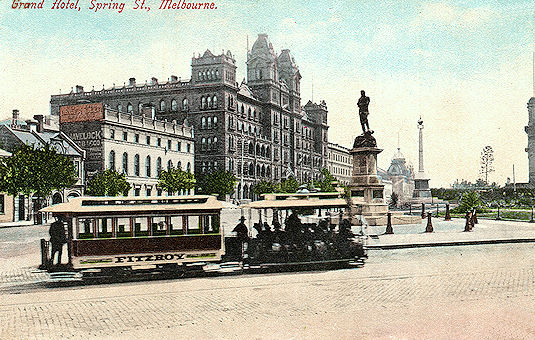

We have looked at this system before (see Postcard) but here is a nice view of a Melbourne cable car in Spring Street in front of the Grand Hotel. It is on the North Fitzroy route which ran from 1886 to 1930. The winding house for this route was located on the north-east corner of Victoria Parade and Brunswick Street and the depot was located at Holden Street near the North Fitzroy terminus. The card is from an unknown publisher but was printed in Great Britain around 1910.
This cable tramway system served the streets of Melbourne, the State Capital of Victoria, Australia, from 1885 to 1940. This pioneering system, inspired by San Francisco's cable trams, was masterminded by Francis Boardman Clapp. Clapp, an American entrepreneur, arrived in Melbourne during the gold rushes of the 1850s and established the Melbourne Tramway & Omnibus Company (MTOC).
The first line of this extensive network, from Spencer Street to Bridge Road Richmond, opened on 11 November 1885. By 1891, the system had expanded to include approximately 75 kilometres of double track, encompassing 1,200 cars and trailers across 15 routes. These lines radiated from central Melbourne.
The system operated under a unique franchise arrangement, initially managed by the MTOC and later taken over by the Victorian Government in 1916. The Melbourne & Metropolitan Tramways Board (MMTB) eventually inherited the network in 1919. Despite the introduction of electric trams in 1889, it wasn't until 1906 that electric traction became more prominent. The gradual conversion from cable to electric trams began in 1924, culminating in the final run of a cable tram on 26 October 1940.